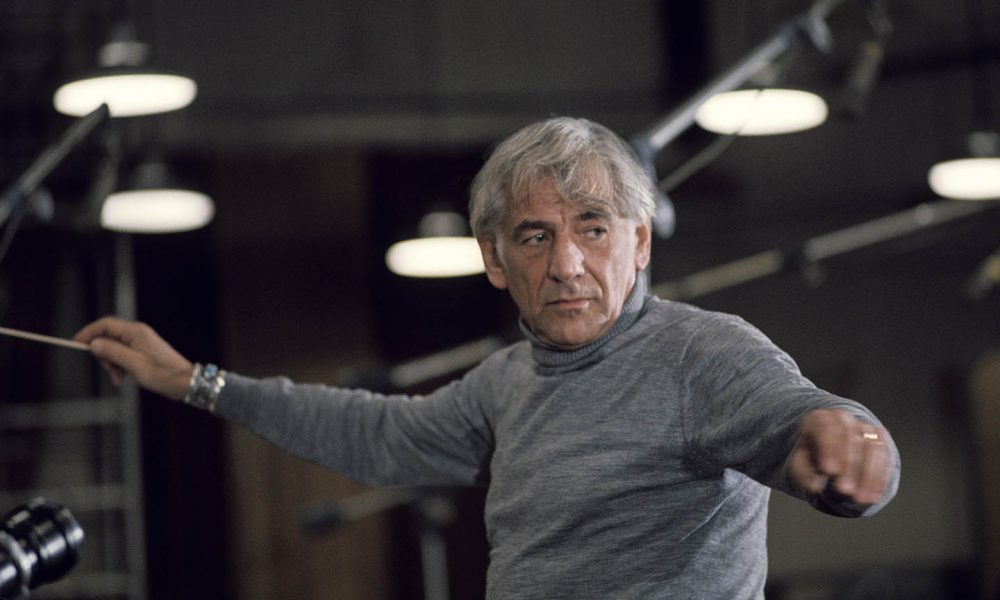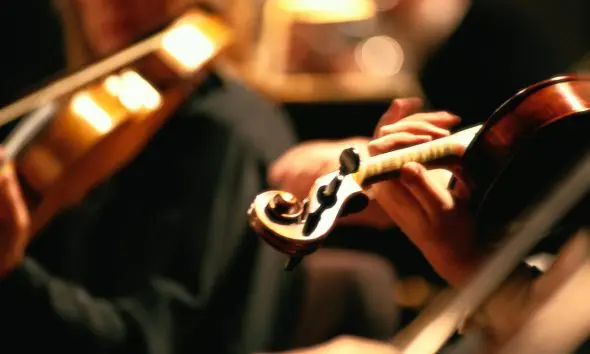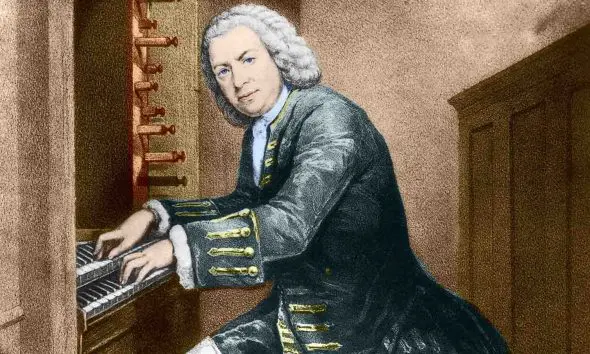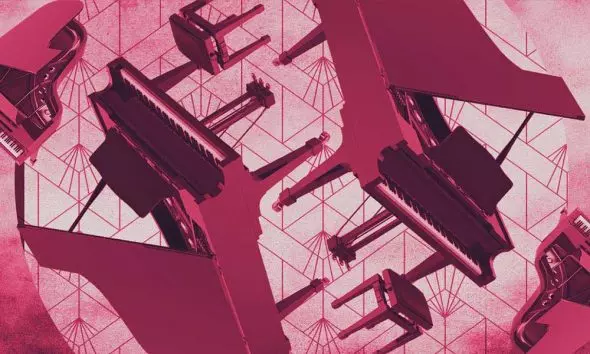Best Leonard Bernstein Works: 10 Essential Pieces
Discover our selection of the best Leonard Bernstein works featuring 10 masterpieces including ‘West Side Story.’

Leonard Bernstein was an American conductor, composer, pianist, writer, teacher, educationalist, activist and one of the most important figures of his generation in the musical life of his country. How enduring his works will be, only history will tell, but at least one composition, West Side Story, is an unquestionable masterpiece. There is also no doubt about his status as one of the great maestros of the twentieth century, and classical music’s most accomplished communicators, able to explore and explain the most complex ideas to young audiences. Scroll down to discover our selection of the best Bernstein works featuring ten masterpieces by the great composer.
Listen to Leonard Bernstein Conducts West Side Story on Apple Music and Spotify.
10: Symphony No. 1 “Jeremiah” (1942)
It was this work that established Leonard Bernstein as an important American symphonist – and indeed sealed his position as a leading American musician – for the premiere of the “Jeremiah” Symphony in January 1944 came just a few months after Bernstein’s legendary conducting debut with the New York Philharmonic when he became the last-minute stand-in for Bruno Walter.
Bernstein’s father Sam had not been supportive of his son’s musical ambitions. When he saw the overwhelming response of the audience that afternoon at Carnegie Hall, he came backstage, overcome with emotion. It led to a rapprochement between father and son, leading the young composer to dedicate “Jeremiah” to his father.
Leonard Bernstein himself explained how the Symphony came into being: “In the summer of 1939, I made a sketch for a Lamentation for soprano and orchestra. This sketch lay forgotten for two years until, in the spring of 1942, I began a first movement of a symphony. I then realized that this movement, and the Scherzo that I planned to follow it, made logical concomitants with the Lamentation.”
The soprano was supplanted by a mezzo-soprano whose sung text comes from the Book of Lamentations. In this, the prophet Jeremiah warned the Israelites that their sinfulness would lead to disaster. His prophecy was fulfilled when Solomon’s Temple was destroyed and Jerusalem fell to the Babylonians in 587 BC. Jeremiah’s Lamentations express his deep sorrow over the resulting desolation, as well as hope for the people of God. The three movements are entitled 1. “Prophecy” 2. “Profanation” 3. “Lamentation”.
9: Prelude, Fugue and Riffs (1949)
This is one of Leonard Bernstein’s most frequently performed shorter concert works, a great favourite with wind ensembles. Here, he attempts to marry classical Baroque forms (prelude, fugue) with jazz, though the latter style very much dominates proceedings. Its original line-up was a standard dance-band instrumentation of solo clarinet, five saxophones and five trumpets, four trombones, piano, string bass, and drums, with a second percussion part added. The first movement (“Prelude”) is written for brass and rhythm; the second (“Fugue”) is scored for the saxes; the third (“Riff”) has the solo clarinet with piano backing, followed by the whole ensemble.
It was written for the Woody Herman band in 1949, after Herman had begun to include “progressive” works such as Stravinsky’s Ebony Concerto in his repertoire. By the time Bernstein had completed his piece, however, the Herman band had disbanded and the work was not heard until October 1955 when it was aired in a television show hosted by the composer, called What is Jazz? The clarinet lead intended for Herman was played by the fabulous Al Gallodoro with ABC-TV Studio Band conducted by Bernstein.
Prelude, Fugue and Riffs, one of Bernstein’s best works, was dedicated to his Tanglewood neighbour and friend Benny Goodman and it was he who made the first recording of the work with the composer in 1966.
8: Candide (1956)
The Overture to Candide is, West Side Story excepted, probably Leonard Bernstein’s best-known and certainly most instantly-recognisable piece. It’s a firecracker of an opener, setting the scene for this operetta, a direct descendant of those by Offenbach and Gilbert & Sullivan. The Overture is widely played – but the operetta is a different matter. Few works have undergone more versions and rewrites.
The idea of adapting Voltaire’s satirical 1758 novella into a musical came from the playwright Lillian Hellman (1905-84). Her many Broadway success included Watch on the Rhine, The Children’s Hour, and The Little Foxes. What appealed to her was the parallel between Voltaire’s ridiculing of the fashionable philosophies of the day – chiefly the Catholic Church and the Inquisition – and the anti-Communist hysteria fuelled by the House of Un-American Activities Committee aided and abetted by the fanatical Joseph McCarthy.
Leonard Bernstein, lyricist John La Touche (soon replaced by the poet Richard Wilbur) and Hellman worked on and off for two years on the project. Bernstein, by 1956, was working simultaneously on West Side Story. Dorothy Parker contributed lyrics to “The Venice Gavotte” while Bernstein and Hellman had also added lyrics of their own to other numbers. Tyrone Guthrie directed. By now, though, the political element had become less urgent. Candide opened in New York on 1st December 1956 to mixed reviews. It closed on 2 February 1957.
The next two decades saw a series of revivals in various new versions. With a revised book from a 1971 production, Hal Prince and Hugh Wheeler devised a new small-scale revival in 1973. Hellman objected strongly and withdrew her adaptation of Voltaire, thus making the original 1956 version of Candide no longer available for performance.
Opening at Brooklyn Academy of Music’s Chelsea Theater, orchestrated by Hershy Kay and conducted by John Mauceri, this was the first critical and popular success for Candide – known as “the Chelsea version.”
Other cuts and changes were made by Bernstein and his collaborators over the years: Stephen Sondheim, for instance, added more lyrics to the 1982 revival for New York City Opera, Bernstein made further revisions for Scottish Opera’s production in 1988. Finally, the score was published in 1994. But, as the Bernstein website admits, “like its hero, Candide is perhaps destined never to find its perfect form and function; in the final analysis, however, that may prove philosophically appropriate.”
Of the many fine numbers (“The Best of all Possible Worlds,” “I Am Easily Assimilated,” “Make our Garden Grow”), none outshines Cunegonde’s aria from Scene 3 “Glitter and be Gay,” a soprano showpiece if ever there was one.
7: Fancy Free (1944)
This ballet is the work that launched the long-standing collaboration between Leonard Bernstein and famed choreographer Jerome Robbins. It was commissioned by the New York Ballet Theatre and first performed on 18th April 1944. The composer described the ballet’s plot as follows: “The action begins with the sound of a juke box wailing behind the curtain. The ballet is strictly young wartime America, 1944. The curtain rises on a street corner with a lamp post, a side street bar, and New York skyscrapers pricked out with the crazy pattern of lights, making a dizzying backdrop. Three sailors explode onto the stage. They are on 24-hour shore leave in the city and on the prowl for girls. The tale of how they meet first one, then a second girl, and how they fight over them, lose them, and in the end take off after still a third, is the story of the ballet.”
More than this, Fancy Free celebrates the vibrant City of New York with a carefree, jazzy score that is also, as you’d expect, hip and cool. The ballet is in seven scenes – actually seven symphonic pieces, though a ballet audience would not identify them as such, so well-integrated is the dance movement to the music. This symphonic element becomes more apparent on recordings. The first of these was made in 1944 by Bernstein with the addition of a song he’d written, “Big Stuff,” to act as a kind of prologue. Initially recorded by his sister, Shirley, Bernstein wrote it specifically with Billie Holiday in mind. It was she who recorded it on a second soundtrack album made in 1946.
6: On The Town (1944)
Fancy Free, one of Bernstein’s best works, was the direct inspiration for his biggest popular success before West Side Story. The idea came from Oliver Smith, the 25 year-old designer of the sets for Fancy Free (it’s worth remembering that Bernstein was only 26 when Fancy Free opened). He and his friend Paul Feigay set out to produce the show with Bernstein writing the score, Robbins choreographing. It was Bernstein who suggested his friends Betty Comden and Adolph Green to provide the book and lyrics.
The team began work just two months after the opening of Fancy Free and brought in the legendary George Abbott to direct (he liked “the kids connected with the show”). The musical could afford to develop and expand the characters of Fancy Free: the three sailors of the ballet are now goofy ladies’ man Ozzie, looking for a date – maybe seven or eight; studious, innocent Chip, guidebook in hand, with several days’ worth of tourist attractions to check off his list; and idealistic Gabey, who falls for a photograph of lovely Miss Turnstiles, a subway beauty queen. Green and Comden themselves played Ozzie and Claire de Loone (a red-hot anthropologist). Variety magazine announced On the Town as “skedded for Broadway this fall […] written, produced and staged by 23 to 25 year-olds headed by Leonard Bernstein, who recently has forged to the front of the ranks of young symphonic composers and conductors.”
The musical was an instant hit. MGM bought the film rights even before the premiere and released the movie in 1949 starring Gene Kelly and Frank Sinatra. The three big hit songs from the show are “Lonely Room” (not sung in the film), “I Can Cook Too,” and the immortal “New York, New York.” It was a significant show in several ways: the first time a symphonic composer collaborated on a Broadway musical, the first time black and white characters were given equal status in stage roles (as sailors and New Yorkers) and the first time Broadway had a black conductor and musical director: Everett Lee took over from Max Goberman nine months into the run.
5: Symphony No. 2 “The Age Of Anxiety” (1949)
All three of Leonard Bernstein’s symphonies are about what he called “the struggle that is born of our century, a crisis of faith”. Thus Symphony No. 1 “Jeremiah” ends with a mezzo-soprano singing the Hebrew prophet’s lamentation over the fall of the temple (the text is from the Book of Lamentations); Symphony No. 3 “Kaddish” has choirs singing Jewish liturgical texts and a narrator in anguished conversation with God.
Symphony No. 2 (1949) has no voices but a solo piano part based on W. H. Auden’s eponymous poem. It’s concerned with the insecurity of our times, and the poet’s search for a faith that can be accepted, even if blindly. Bernstein follows the passage of the poem in a work he divided into two parts. Part 1: The Prologue; The Seven Ages (Variations 1-V11); The Seven Stages (Variations V111-X1V). Part 2: The Dirge; The Masque; The Epilogue. Bernstein provided a detailed program for the music which concerns four lonely characters – a girl and three men – whom we first meet “in a Third Avenue bar, all of them insecure, and trying, through drink, to detach themselves from their conflicts, or, at best, to resolve them”.
Bernstein began the work in 1947 but because of his myriad commitments around the world was compelled to write it in fits and starts wherever he happened to be. The orchestration was finally completed on 20 March 1949 and introduced just a fortnight later by the Boston Symphony Orchestra conducted by Serge Koussevitsky. Bernstein played the piano part which – a guilty pleasure for many – includes a wildly virtuosic jazz scherzo movement, providing a stark contrast to the serious and solemn character of the rest of the Symphony. It was turned into a ballet in 1950 by Jerome Robbins and again in 2014 by Liam Scarlett.
4: Mass – A Theatre Piece for Singers, Players and Dancers (1971)
This mammoth work – its running time is around 110 minutes – was written at the request of Jacqueline Kennedy Onassis for the 1971 inauguration of the John F. Kennedy Center for the Performing Arts, in Washington, D.C. Leonard Bernstein had dedicated his “Kaddish” Symphony to the memory of the assassinated president and had also conducted the funeral service of Robert F. Kennedy in 1968.
He decided to compose a work based on the Tridentine Mass of the Roman Catholic Church with liturgical passages sung in Latin and Hebrew, but additional contemporary texts in English written by Bernstein himself and the Broadway lyricist and composer Stephen Schwartz who had recently (1971) had a smash hit with the musical Godspell based on the Gospel of St Matthew.
This was to be no straightforward mass setting for the church, though. The two wanted it to be a theatrical event, “a dramatic pageant,” in which the sacred texts would be questioned and challenged and reflected upon. The left-leaning liberal Bernstein wanted to produce a work that stimulated debate at a time in U.S history that had left the country confused and divided after the Vietnam War, atrocities such as the My Lai Massacre, and incursions into Laos and Cambodia. “These turbulent times produced a restless youth culture that hungered for a trustworthy government and for spiritual authority that reflected their values.” Mass, Bernstein believed, gave a voice to these concerns.
The ceremony is performed by a Celebrant accompanied by a formal choir, a boys’ choir, acolytes, and musicians. His congregation of disaffected youths (the “Street Chorus”) sings the questioning texts that challenge the formal ecclesiastic dogma of the Church. Ultimately, Mass serves as a reaffirmation of faith and hope for universal peace. It begins and ends with the sublime “A Simple Song,” an affirmation of the pure faith at the heart of the mass. (Bernstein had originally written the song for Franco Zeffirelli’s film Brother Sun, Sister Moon before withdrawing from the project.)
The musical styles adopted by Bernstein reflect every aspect of his eclectic tastes: blues, gospel, rock, musicals, jazz, tonal and atonal classical music, hymns, marches, dances and chorales. Mass was first presented at the opening of the Kennedy Center on 8th September 1971. The fully-staged performance required 200 participants with an orchestra augmented by a concert organ, rock organ, rock musicians, a robed choir of 60 in addition to the Street Chorus.
3: On The Waterfront – Symphonic Suite (1955)
We’ve seen Leonard Bernstein the operetta composer, ballet composer, musical composer, chamber music and choral composer – now here is Bernstein the film composer. On the Waterfront, one of Bernstein’s best works, is his only original film score not adapted from a stage production with songs. It opened in New York City on July 28, 1954. Directed by Elia Kazan with Marlon Brando and Eve Marie Saint – all of whom won Academy Awards for their contributions – the film won eight Oscars in all (Bernstein’s score was nominated but didn’t win).
Bernstein initially turned down the assignment, but after a private screening of the film with Kazan and Brando, lucrative financial and rights offers, and the promise of prominent billing, he relented. He moved to Los Angeles where he watched and rewatched a rough cut of the film, learning how to score a picture as he went along. He recorded the music in late April, then turned it over for mixing.
The task was not one he enjoyed. “I had become so involved in each detail of the score that it seemed to me perhaps the most important part of the picture,” he wrote in a New York Times piece. “I had to keep reminding myself that it really is the least important part: that a spoken line covered by music is a lost line; and by that much a loss to the picture; while a bar of music completely obliterated by speech is only a bar of music lost.”
Much more to his liking was the creation of a 22-minute concert suite from the film score. The orchestration is for piccolo, 2 flutes, 2 oboes, 2 clarinets, E-flat clarinet, bass clarinet, alto saxophone, 2 bassoons, contrabassoon, 4 horns, 3 trumpets, 3 trombones, tuba, 2 timpanists, percussion (bass drum, chimes, cymbals, glockenspiel, snare drums, tam-tams, triangle, tuned drums, vibraphone, wood block, xylophone), harp, piano, and strings. It was premiered on August 11th, 1955 at the Tanglewood Festival, Boston (the Boston Symphony Orchestra conducted by the composer).
The Suite, like the film, opens starkly with a solo French horn playing Terry’s theme (Terry Molloy, played by Brando, who memorably “could have been a contender”). As the Hollywood Bowl program describes it, “bursts of brass give way to a quick, sharp-edged melody of conflict and fear. The love theme for Terry and Edie emerges on flute, sweet and uncertain, floating around an oboe counterpoint …Danger sets in, spiking the love theme with the threat of tragedy …The watery sounds of a vibraphone give Terry’s theme an exotic edge, and over stumbling timpani, the melody rises in defiance. The love theme comes to its aid and the two intertwine, as a crashing timpani coda resolves the suite on a note of grand tension.”
2: Chichester Psalms (1965)
In early December 1963, Leonard Bernstein received a letter from the Very Reverend Walter Hussey, Dean of the Cathedral of Chichester in Sussex, England, requesting a piece for the Cathedral’s 1965 music festival: “The Chichester Organist and Choirmaster, John Birch, and I, are very anxious to have written some piece of music which the combined choirs could sing at the Festival to be held in Chichester in August, 1965, and we wondered if you would be willing to write something for us. I do realize how enormously busy you are, but if you could manage to do this we should be tremendously honored and grateful. The sort of thing that we had in mind was perhaps, say, a setting of the Psalm 2, or some part of it, either unaccompanied or accompanied by orchestra or organ, or both. I only mention this to give you some idea as to what was in our minds. Many of us,” Hussey wrote, “would be very delighted if there was a hint of West Side Story about the music.”
Hussey had chosen a good time to make his request: not only was Bernstein taking a sabbatical from his post as music director of the New York Philharmonic but a projected musical based on Thornton Wilder’s The Skin of Our Teeth had fallen through. Bernstein accepted the assignment and responded with a “suite of Psalms, or selected verses from Psalms”. He had written nothing since the “Kaddish” Symphony (except six months of 12-tone music which he ended up throwing away). Chichester Psalms as the new work was titled was, in his words, “the most accessible, B-flat majorish tonal piece I’ve ever written.” Bernstein characterized it as “popular in feeling …with an old-fashioned sweetness along with its more violent moments.”
Chichester Psalms, one of Bernstein’s best works, is in three movements and scored for boy treble (or countertenor), choir, and orchestra. The text, arranged from the Book of Psalms by the composer, is sung in the original Hebrew (there is not even an English translation in the score). It was premiered by Bernstein in Philharmonic Hall, New York City on 15th July 1965, followed by its Chichester / UK premiere 16 days later conducted by the cathedral’s music director John Birch.
1: West Side Story (1956)
Many believe that Leonard Bernstein wrote his best music when he was young. Others believe, in addition, that the best of his music was written when he was under pressure, or in a short period. He was 39 when his masterpiece was premiered. Whether or not he would be happy about it is a moot point, but it is his ground-breaking musical, West Side Story, that is the first work everyone can name when Bernstein’s name is mentioned. Many will only know this one composition by him and be unable to name any other. It’s that famous and that good.
The idea for the musical came from Bernstein’s choreographer friend Jerome Robbins who approached him and playwright Arthur Laurents in 1947 about collaborating on a musical about the conflict between an Irish Catholic family and a Jewish family. It was to be a contemporary adaptation of Shakespeare’s Romeo and Juliet and was originally going to be called East Side Story. Having realized that this theme had already been explored, the three went their separate ways and the project was shelved for nearly five years.
A series of events led to the three reviving the musical, now entitled West Side Story, and revolving around two delinquent gangs – not Irish v. Jewish, but Polish / American v. Puerto Rican. Bernstein decided to concentrate on the music, which was when the team brought in the young Stephen Sondheim, whose first Broadway musical this would be, to write the lyrics (he at first turned down the offer but was persuaded to change his mind by Oscar Hammerstein 11 who said he would “benefit from the experience”). Bernstein was working concurrently on Candide leading, interestingly, to some music for one work being transferred to the other. For instance, the duet “One Hand, One Heart” and the music for “Gee, Officer Krupke” were both originally intended for Candide.
The show was completed by the autumn of 1956 and finally premiered in Washington, D.C. on August 19th, 1957 before moving to Broadway where it opened on September 26th. It ran for 732 performances, and might have won the 1958 Tony Award for best musical had its competition not been The Music Man. In 1961, adapted for the silver screen, West Side Story took 10 Academy Awards, including best picture. It remains America’s most frequently performed musical and is the best Bernstein work.
In the opening weeks of 1961, Bernstein revisited his score for West Side Story and extracted nine sections to assemble into what he called the Symphonic Dances. Two of the most popular favourites of the musical’s songs are found in the pages of the Symphonic Dances: “Somewhere” and “Maria” (in the Cha-Cha section), though not the also-beloved “America,” “One Hand, One Heart,” “I Feel Pretty,” or “Tonight.”
Recommended Recording
In 1984, 27 years after the premiere, Leonard Bernstein conducted the complete score of West Side Story for the first time. The all-star cast for Leonard Bernstein Conducts West Side Story features Kiri Te Kanawa as Maria and José Carreras as Tony.
Leonard Bernstein Conducts West Side Story can be bought here.




